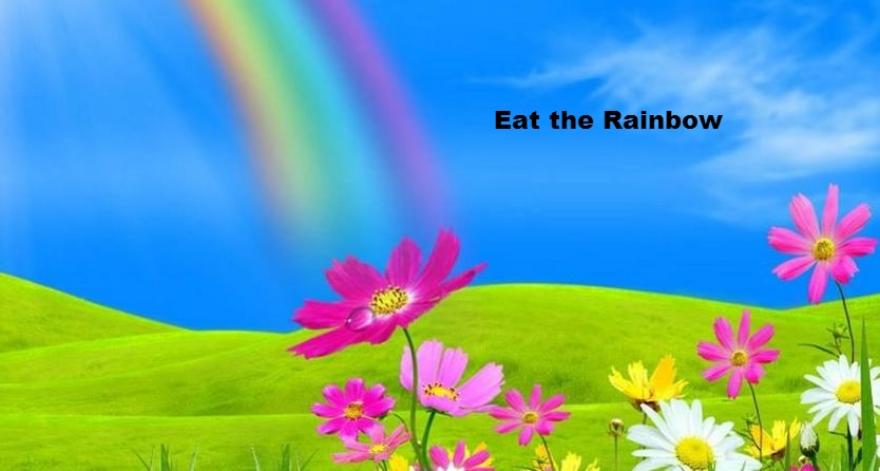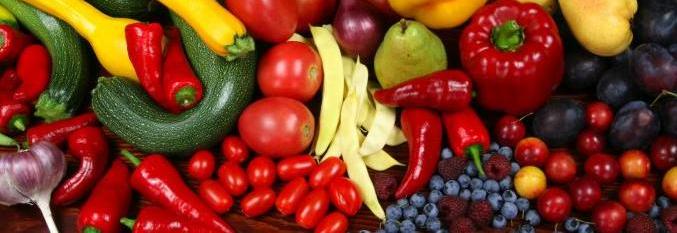Translate This Page

The Color of Health . Eat the Rainbow
Did you know that adding color to your plate may add years to your life?
The natural pigments that make fruits and vegetables so colorful can also help protect your body from common diseases and illnesses as you age. Think color! The bright red of ripe tomatoes, strawberries, cherries, and cranberries; the brilliant orange of carrots; the vibrant green of kiwifruit and kale; and the dramatic purple of Concord grapes.
Scientists in labs across the country have made astounding discoveries about the health benefits of highly pigmented fruits and vegetables, which contain disease-fighting compounds called phytonutrients. These powerhouses act as a rogue police force, fighting off free radicals that cause cancer and a host of other enemies that increase your risk of heart disease, diabetes, osteoporosis, and more. Here’s just a sampling of the health benefits of eating colorful fruits and vegetables.
- The red in tomatoes helps reduce the risk of heart disease, prostate cancer, and other types of cancers.
- The yellow in corn protects against macular degeneration, the number-one cause of blindness in the elderly.
- The orange in carrots and sweet potatoes helps prevent heart disease by lowering cholesterol and helps reduce the risk of stroke.
- The green in dark, leafy greens helps prevent cancer.
- The blue in blueberries helps protect memory and motor function as you age, and helps fight cancer and heart disease.
- The purple in Concord grapes and grape juice helps prevent heart disease.
So when you’re filling your shopping cart or your plate, think the more color, the better!
RED
Red, the most physical and sensual of the colors, vibrates the most slowly and has the longest wavelength in the visible spectrum. Red is stimulating, hot (yang), and exciting; it is associated with vitality, strength, passion and willpower.
Red stimulates the sympathetic nervous system. It can be used to treat anemia, colds, low blood pressure, erectile dysfunction, fatigue, weakness and depression. It helps one feel present and grounded. Use red when feeling run down, to improve athletic performance, and when quick energy bursts are required. A study done on athletes at the University of Texas indicated that viewing red light increased strength by 13.5 percent and produced 5.8 percent more electrical muscle activity.
When red is present in food, it often denotes ripeness or sweetness, as well as the presence of lycopenes, quercetin, and Vitamin C. Because red is so energizing, it should be avoided in decorating eating areas, as it makes diners feel hurried. In packaging, however, red is attention getting and highly visible, so you'll find it often on supermarket shelves.
May reduce the risk of certain types of cancer. May reduce the risk of cancer, heart disease, and complications from diabetes. May help control high blood pressure and slow some effects of aging.
Red is an energetic frequency found to stimulate physicality. Red fruits and vegetables promote health of the adrenals, gonads, colon, legs and red blood cells. Red fruits and vegetables also contain powerful phyto-chemicals such as lycopene and anthocyanins which are essential for the circulatory system.
- Cayenne
- Cherries
- Cranberries
- Dulse (seaweed)
- Goji Berries
- Guava
- Hibiscus Flowers
- Kidney beans
- Pink beans
- Pink Grapefruit
- Pomegranate
- Radishes
- Red Cabbages
- Red Corn
- Red Currants
- Red Peppers
- Red Plums
- Red Tomatoes
- Rhubarb
- Rose Hips
- Strawberries
- Watermelon
- Whole Wheat
ORANGE
Orange is the blending of red (physical action) with yellow (wisdom). It symbolizes enthusiasm, outgoingness, optimism, confidence, joyfulness, and courage.
Orange can lift spirits, foster humor, and loosen repression. Orange is associated with the sexual center, skin, kidneys, pancreas, spleen, and bronchial tubes. Use orange to help relieve asthma, bronchitis, constipation, diarrhea, gas, hemorrhoids, and hypoglycemia.
In plant foods, orange is often an indicator of high carotene content. Being a social color, orange is useful for decorative highlights in places where people gather, such as family rooms. Fast-food restaurants use orange to attract lots of people without encouraging them to linger.
May reduce the risk of cancer and heart disease. Helps maintain good vision and strengthens the immune system. May strengthen bones and teeth, help the body heal wounds, keep skin healthy and maintain eyesight.
Orange is the color of passion, optimism and tolerance. Orange colored fruits and vegetables contain antioxidants such as vitamin C and Cartenoids. Orange fruits and vegetables are vital for maintaining healthy reproductive and neuro/endocrine systems.
- Almonds
- Apricot
- Butternut Squash
- Cantaloupe
- Coriander
- Kumquat
- Mangoes
- Nectarines
- Orange Carrot
- Orange Marigold Flowers
- Orange Peppers
- Orange Tomatoes
- Oranges
- Papayas
- Paprika
- Peaches
- Persimmons
- Pumpkin
- Sweet Potatoes
- Tangerines
- Walnuts
- Winter Squash
YELLOW
Yellow is warm (yang) and is associated with things sunny, cheerful, joyous, optimistic, practical, confident, and illuminating. It is also associated with wisdom, knowledge, logic and the mind.
Yellow is used to benefit the adrenal glands, gallbladder, liver, muscles, nervous system, pancreas, and stomach. Illnesses that can be treated with yellow are allergies, arthritis, asthma, constipation, coughs, depression, diabetes, eczema, gallstones, gas, hiatal hernia, hypothyroidism, indigestion, lymphatic congestion, motion sickness, and obesity. Yellow is a nerve stimulant; it can be helpful with depression, fear, and tension, and can soothe mental exhaustion.
Yellow in food often indicates the presence of lutein, magnesium, and Vitamin C and limonene. Because it is a sharpening color that enhances alertness, concentration, communication, and focus, you will often find yellow on food packaging.
May reduce the risk of cancer and heart disease. May strengthen bones and teeth, help the body heal wounds, keep skin healthy and maintain eyesight.
Yellow is happy, warm radiant and represents the Solar Plexus. Yellow whole foods are loaded with many antioxidants and phytochemicals which help promote healthy function of the liver, gall bladder, pancreas as well as other vital organs and the nervous system.
- Anise Seed
- Bamboo Shoots
- Bananas
- Chamomile
- Cinnamon
- Corn
- Dill
- Evening Primrose Flowers
- Garbanzo beans
- Golden Apples
- Golden Flax Seed
- Golden Raisins
- Grapefruit
- Honey
- Lemongrass
- Lemons
- Nuts
- Parsnips
- Pears
- Pineapple
- Saffron
- Spaghetti Squash
- Squash Blossoms
- Vegetable Oils
- White Carrot
- Whole Grains
- Yams
- Yellow beans
- Yellow Marigold Flowers
- Yellow Peppers
- Yellow Raspberry
- Yellow summer squash
- Yellow Tomatillo
- Yellow Tomatoes
- Yellow Wax Beans
- Yellow Zucchini
GREEN
Green is made by combining yellow (wisdom) with blue (spirituality). Being in the middle of the color spectrum, it is neither hot nor cold. Green is the color of the heart center, healing, balance, compassion, love, transformation, growth, generosity, and peace.
Green is rejuvenating and anti-inflammatory. Green can help calm anger and improve memory, paranoia, and nervous exhaustion. It affects the lungs, heart, thymus gland, and immune system. Use green for backaches, heart trouble, immune disorders, lupus, allergies, head colds, shock, and trauma, and to lower blood pressure.
Green in plants signifies the presence of chlorophyll. We see green as clean, crisp, and refreshing, and so is often used to market cleaning products.
Helps maintain eyesight and may reduce the risk of vision problems common later in life. May reduce the risk of cancer and help the body get rid of cancer-causing chemicals.
Green is considered a healing color and is associated with the heart. Green fruits and vegetables contain phyto-chemicals such as luteins and indoles which are good for the heart. They are also high in fiber and promote a healthy digestive system.
- Alfalfa
- Asparagus
- Avocados
- Beet Greens
- Bok Choy
- Broccoli
- Brussels Sprouts
- Cactus (Nopales)
- Celery
- Chives
- Collard Greens
- Comfrey
- Cucumber
- Dandelion Greens
- Edamame
- Fennel
- Green Beans
- Green beans (e.g. green Lima)
- Green Cauliflower
- Green Eggplant
- Green grapes
- Green Olives
- Green Peppers
- Green Tomatoes (green when ripe)
- Green Zucchini
- Honeydew
- Kale
- Kiwi
- Leafy green vegetables
- Lettuce
- Limes
- Mint
- Nettles
- Okra
- Oregano
- Parsley
- Peas
- Pumpkin Seeds
- Rosemary
- Sinqua
- Spinach
- Swiss Chard
- Tarragon
- Tomatillo
- Wasabi
- Wheatgrass
BLUE
Blue is cool (yin), crisp, clean, and refreshing. Blue is associated with spirituality, serenity, truth, communication, revelation, trust, and faith. Its effect is calming and instills gentleness and composure. Blue can be used to counteract violence, restlessness, agitation, hyperactivity, violence, and insomnia.
Being a counterirritant, blue is the color of choice to soothe pain and suffering. It causes the brain to secrete tranquilizing chemicals. Blue can be used to lower blood pressure, pulse rate, and brain wave activity, and to quiet menstrual cramps. Use blue for a fever, sore throat, ear infection, toothaches, bee stings, hyperthyroid, colic, burns, itches, and rashes. It is also used in hospital neonatal wards to facilitate the breakdown of biliruben in jaundiced babies.
Blue foods are often rich in flavonoids. Blue is not always a good color for decorating a social area due to its quieting, cooling effect.
May reduce the risk of cancer, heart disease, and complications from diabetes. May help control high blood pressure and slow some effects of aging.
Blue is the color of enthusiasms, expression and loyalty. Blue fruits and vegetables are believed to have many anti-aging benefits and contain vast amounts of health promoting phytochemicals such as anthocyanins and phoenolics which are beneficial to the muscular and skeletal systems.
- Blue grapes
- Blue potatoes
- Blueberry
- Borage Flowers
- Catnip
- Cauliflower
- Chicory Flowers
- Blue Corn
- Hyssop
- Juniper Berries
- Kelp (seaweed)
- Pansy Flowers
- Purple Broccoli
- Purple Carrot
INDIGO
Indigo, a regal, dark blue-violet, is cool (yin) and calming. It is associated with our psychic awareness, intuition, and memory.
Indigo is soothing and antiseptic. It can help balance fear, frustration, and negative emotions; it helps one to be less aware of pain yet fully conscious. Use indigo for pain, poor motor skills, posture, menstrual irregularities, hair loss, and eye and ear disorders.
In foods, indigo appears as a blue with a black overtone, as in black beans, blackberries, or plums. Indigo foods are often good sources of Vitamin K and lycopene.
Indigo is inspiration, imagination and peace of mind. Similar to blue, indigo fruits and vegetables are high in antioxidants and phyto-chemicals which help promote healthy function of the brain, pituitary gland, sinus, vocal cords and the lungs, as well as boosting the immune and respiratory systems.
- Black Beans
- Black Cherries
- Black Currants
- Black Olives
- Black Raspberry
- Black Soybeans
- Blackberry
- Boysenberries
- Plums
- Prunes
- Raisins
- Tamari (soy sauce)
- Vanilla Beans
- Violet Flowers

VIOLET
Violet is a mix of blue (spirituality) and red (passion), is considered regal, dignified, and exclusive. It is cooling (yin), cleansing, antiseptic, soothing, and narcotic. Violet symbolizes creative imagination and spiritual attainment, and corresponds to psychic protection, artistry, and mystery. It correlates to cosmic consciousness; with violet, we can be more open to divine power.
Violet helps normalize hormonal activity, curb appetite, and regulate metabolism. It is said to be more sexually stimulating to women. Use violet to treat migraines, epilepsy, parasites, dandruff, and baldness, to soothe serious mental conditions, and to relive the side effects of chemotherapy.
Violet foods are rich in Vitamin D.
Violet is a higher frequency of color associated with universal love, selflessness and understanding. Violet whole foods tend to contain essential phyto-chemicals and fatty acids which are beneficial for the cerebral cortex, pineal glad, hypothalamus and upper brain function, as well as the lymphatic system.
- Basil Flowers
- Black Tomatoes
- Dulse (seaweed)
- Elderberries
- Kohlrabi
- Lavender
- Marjoram
- Mint Flowers
- Mulberries
- Passionflower
- Passionfruit
- Purple (Red) Onions
- Purple Cabbage
- Purple Eggplant
- Purple Grapes
- Purple Green Beans
- Purple Peppers
- Purple Plums
- Rosemary Flowers
- Sage Flowers
- Thyme Flowers
BLACK
Black foods are associated with the kidneys and bladder in Asian medicine. Foods that are black in color are usually rich in minerals.
- Black Beans
- Black Flax Seed
- Black Quinoa
- Black Sesame Seeds
- Seaweeds
- Wild Rice
WHITE
White is associated with the top of the color spectrum (crown chakra) and, in Asian medicine, with strengthening to the lungs and large intestines. White foods are often rich in sulfur and quercetin.
May reduce the risk of cancer and help the body get rid of cancer-causing chemicals.
- Buckwheat
- Cauliflower
- Chermoya
- Coconut
- Garlic
- Green Onions / Scallions
- Horseradish
- Jicama
- Millet
- Mushrooms
- Quinoa
- Shallot
- Sunflower Seeds
- Tofu
- Turnip
- White Beans
- White Corn
- White Eggplant
- White Onions
- White Radishes
- White Sesame Seeds
- White Tomatoes











